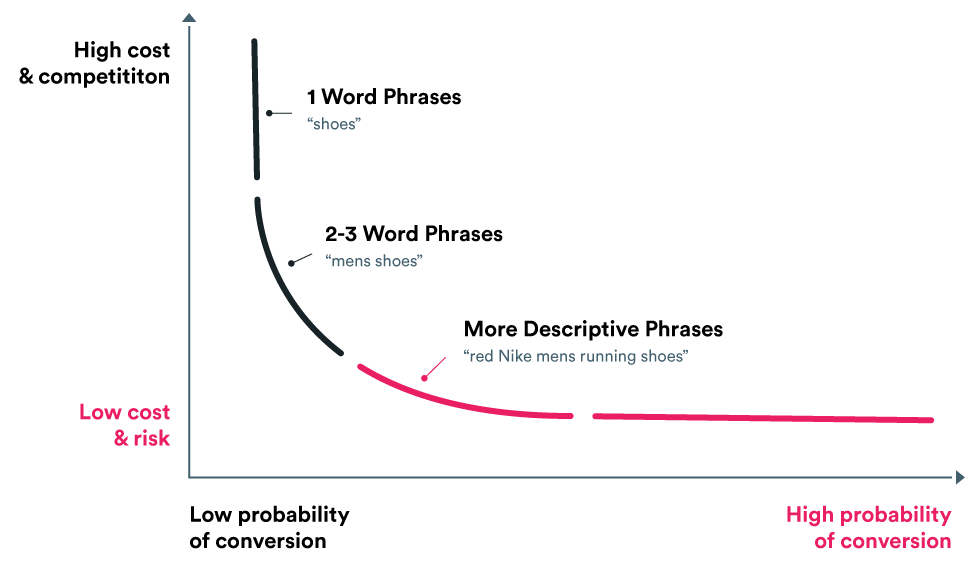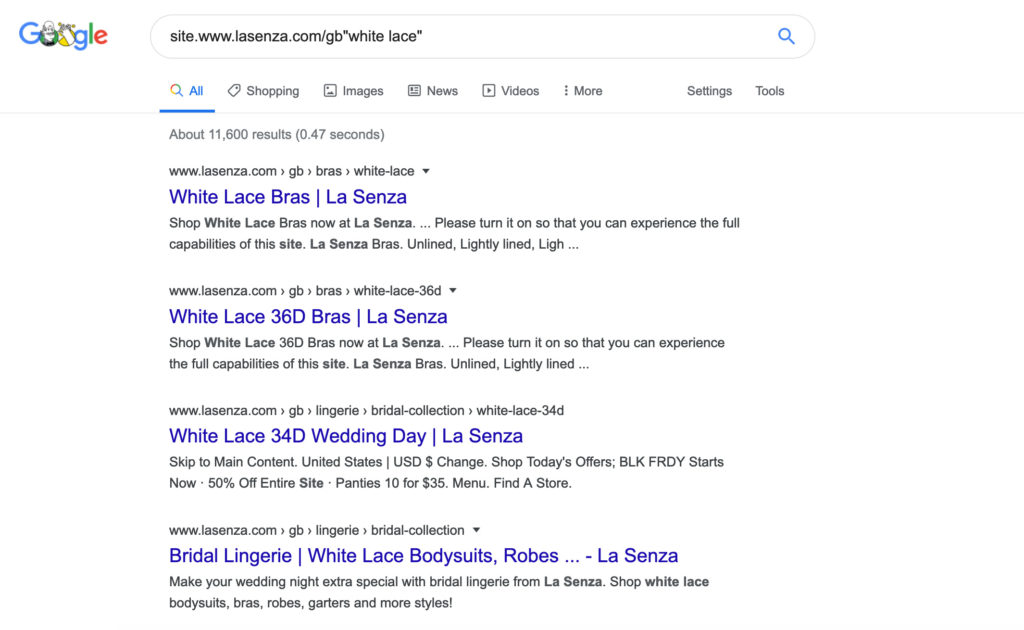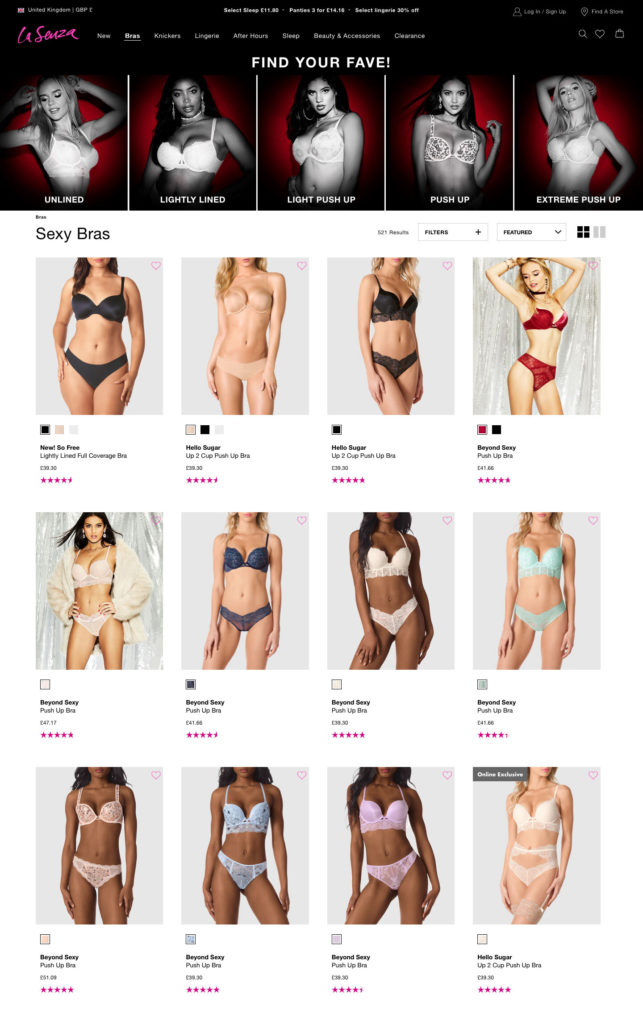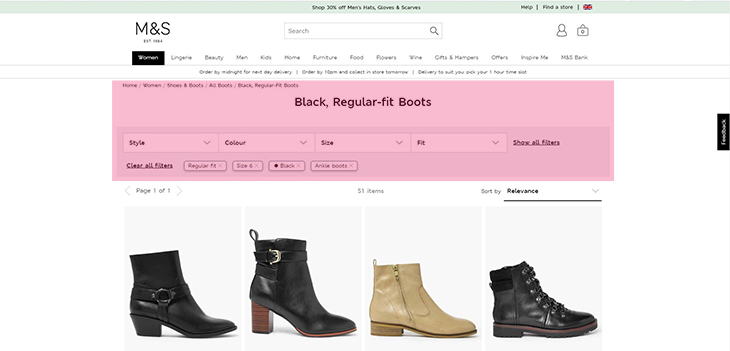What are long-tail keywords?
Long-tail search terms typically combine a string of three or more words. Their length makes them highly specific as the user is able to elaborate on what they’re looking for. For example, the search term “women’s red ski jacket size 10” is far more descriptive than “women’s ski jackets”. It is, therefore, very often the case that long-tail search terms have a higher purchase intent.

While it’s important to make clear that you should continue to optimise for key head terms, long-tail variants account for up to 70% of all organic searches. Their value is greater than their individual parts and can unlock key advantages previously undiscovered by many ecommerce websites.
You can do this through the utilisation of your product facets, which have traditionally been used for enhanced user experiences and not strictly for SEO purposes.
Identifying and targeting suitable long-tail keywords on your ecommerce site
By their very nature, long-tail keywords are synonymous with informational content like blog articles. These coincide with brochure websites where the intent is to educate, but what about ecommerce sites where the goal is drive online sales?
The key is to leverage dynamic URLs that reflect your product facets (i.e. attributes). For example, the term “smart TV” will exist as a subcategory page. With the correct taxonomy, you will have facet groups for:
- screen size (64 inch)
- technology (smart)
- screen type (curved)
- resolution (HD)
These facet-generated URLs are typically blocked, which means they’re not crawled or indexed by the search engines and the potential issues cited above are avoided. So which URLs should you open up to crawlers? Before you decide, and potentially allow for a whole number of possible combinations, it’s essential that you create a clear plan of action.
Conduct keyword research
Find the facet combinations that not only frequently appear but collectively result in sizeable monthly search volumes. Take a look at these lingerie keywords that have a high proportion of fabric, colour and size specifications*.
Long-tail keywords around “lace bras”
| Keyword | Avg. Monthly Searches | Competition |
|---|---|---|
| lace bralette | 9900 | High |
| lace bra | 4400 | High |
| black lace bralette | 3600 | High |
| white lace bralette | 2400 | High |
| black lace bra | 1300 | High |
| white lace bra | 1000 | High |
| black lace bralette top | 1000 | High |
Long-tail keywords around “white bras”
| Keyword | Avg. Monthly Searches | Competition |
|---|---|---|
| white lace bralette | 2400 | High |
| white strapless bra | 1300 | High |
| white lace bra | 1000 | High |
| white push up bra | 720 | High |
| black lace bra | 1300 | High |
| white strapless push up bra | 260 | High |
| white padded sports bra | 170 | High |
| white push up bralette | 140 | High |
*This is only a small sample of data for illustrative purposes.
La Senza, the Canadian lingerie brand, executed this approach, which has incorporated [colour] [fabric] landing pages into its international SEO strategy.

While these pages could be optimised further with improved page titles, meta descriptions, H1 tags and well-crafted category descriptions, they’ve grouped relevant products into a range of facet landing pages. For instance, https://www.lasenza.com/gb/bras/white-lace. This is a huge benefit as they are more likely to secure top rankings for these highly searched for phrases and, as such, secure incremental traffic gains.

Harness your data
It’s also worth looking through your GA and GSC data alongside your PPC activity (if applicable) to determine which keywords and URLs are driving the highest traffic, onsite engagement and web conversions. Again, grouping this data into relevant subtopics should indicate the size of the opportunity.
Avoid over indexation
To avoid unnecessary pages being indexed in the organic SERPs, it’s important to decide how many facet groups you will allow for page generation and how many values these will contain.
You can do so by looking at linguistics. For example, in English speaking countries, we don’t use more than four adjectives to describe a single object. Therefore, it generally makes sense to select up to four facet categories. However, this is only a guide. The number will vary from industry to industry. Your keyword research and associated estimated search volumes will steer how many levels you can open up.
The next step is to cross-reference this with your product offering. This is because if you only have 10 or so products within that category, there’d be little point creating an entire category listings page for such a small range. This is why you should aim to continuously check and cross-reference your categories and product pages as you may get an influx of a particular product that will then require its own listings page in future.
Now it’s time to find any double negatives. For example, a user would not search for a “maxi skirt” and “midi skirt” at the same time. They will be searched for independently, which classifies the grouping as irrelevant and is an indication that you should remove them from your facet optimisation strategy. Instead, they will continue to be generated by on-page filters and shall exist as non-indexable results.
There are some categories that provide little to no value from facet optimisation, i.e. delivery options, price/offers and customer ratings. As it doesn’t make sense to have indexable pages around these broad and excessively low search terms they should be automatically discounted and removed from your long-tail optimisation plan. You can do this by employing a number of technical solutions.
Create a defined parameter for those irrelevant combinations first and disallow them in your robots.txt file.
- Add <meta name=”robots” content=”noindex, nofollow”> tag at the page level.
- Canonicalize the unnecessary facets to its parent page (note: these are regarded as hints for the search engines to follow so we can’t rely solely on them).
- Define them with Google Search Console’s URL Parameter tool. While this won’t resolve the issues, it’ll tell Google what effect the parameters may have on a page and how it should treat them. Note: these are hints not directives, so it’s possible that Googlebot won’t obey them. They also won’t work for Bing or Yahoo user-agents.
- An additional step you could add is <a href=”link URL” rel=”nofollow”> which attributes at the link level. While Google now considers these as a hint and not a directive, I think it’s still worthwhile to apply to your source code, if only to reinforce your intention.
On the other hand, you should identify where multiple selections naturally co-exist and may have relevant search volume to rank for. The best illustration of this is the colour facet where it’s reasonable to expect someone to simultaneously look for two or more combinations (e.g. “navy and white dresses”). This query will produce an indexable page that lists all navy, white and navy/white dresses (for all style and fabric options). Looking at data from Google Keyword Planner, we can see that this phrase alone produces over 500 variations with an estimated search volume of 14,910 per month.
| Keyword | Avg. Monthly Searches |
|---|---|
| blue and white dress | 1900 |
| blue and white striped dress | 1300 |
| blue white dress | 390 |
| blue and white floral dress | 390 |
| blue and white polka dot dress | 260 |
| blue and white maxi dress | 210 |
| blue and white striped dress | 210 |
| blue and white spotty dress | 210 |
| Total = 4,870 |
Avoid duplicate listings
The next stage of the process is to work out the order in which facet selection will generate new URLs. If you allow the combinations to be indexable regardless of the order – or even worse, in multiple ways – depending on the sequence a user chooses the facets, you’ll end up with a significant duplication issue. This will inevitably contribute to indexation bloat and crawl budget issues, which will ultimately damage your organic rankings.
To avoid this, you should curate a logic to consistently order the search parameters into the URL, irrespective of the order in which the filters are chosen by the visitor. This will ensure that only one indexable version exists and no cannibalisation issue arises. We would also recommend that they are displayed in the order that reflects their search demand and priorities. For example, from highest monthly searches to the lowest and/or natural speech such as grammar rules that order multiple adjectives such as “white cotton t-shirt” rather than “cotton white t-shirt”. This will ensure that the most important characteristics are highly visible for visitors to scan.
To achieve this from a development point of view, you’ll have to create a rule to determine the ‘order logic’. An example of this is:
| First Facet Selected | Second Facet Selected | Recommended Facet URL path |
|---|---|---|
| Silk | Red | /colour_red,fabric_silk |
| Red | Silk | /colour_red,fabric_silk |
| White | Cotton | /colour_white,fabric_cotton |
| Cotton | White | /colour_white,fabric_cotton |
Structure your facet-generated URLs
For each product category, you should arrange the named facet groups according to their comparative value of significance or priority. For example, “size” is very significant and has a higher search volume for electrical goods, like TVs and laptops, but this isn’t the case for game consoles or electric toothbrushes. By identifying this, you’ll highlight which priority the facets should feature in your new URLs.
One crucial consideration to bear in mind is how many characteristics you wish to base the rule on. After all, many product categories can have five or more facet groups. The best way around this is to consider that we typically order adjectives like so:
- Size
- Brand
- Shape
- Colour
- Material
[Product Type]
Keep in mind that facet ordering logic (as explained above) is very different to facet selection logic. The former deals solely with duplication while the latter picks the top values in conjunction with search demands and linguistics.
Build page authority through strategic internal links
Once you’ve chosen your preferred facet-generated URLs, be mindful that they don’t exist as orphan pages. With no internal links pointing towards them, all of your hard work will inevitably go to waste. They won’t be accessible for the search engines to crawl or index (regardless of your meta robot tags); site authority won’t be channelled down to them, and users won’t be able to navigate and engage with them. You can prevent this from happening by considering how and where these new pages will be linked from. Here are four recommendations:
- If you have opted to have one feature facet URL, then you don’t need to look any further than the filter navigation on your category and subcategory listing page (PLPs). Nevertheless, if you have a blog or a style guide on your site then think about curating relevant articles that include links with long-tail anchor texts.
- If you decide to have two or more features per facet URL then this gets a little more complicated. The best solution is to use a ‘popular searches’ or ‘related searches’ option within your main category pages.
- Include the links in your mega menu as they get the biggest proportion of link equity and highest number of click-throughs.
- Update your XML and HTML sitemaps if they do not do so automatically. This will ensure that they accurately reflect the live pages on your site, thereby providing the search engines with a blueprint of how your website is structured and what pages you wish to be crawled and indexed in the SERPs.
Due to the number of pages you could potentially create, you should also make sure that they are being ‘automatically’ linked to via the href links in the HTML. This means that you won’t be solely relying on links from the main navigation or having to add them into your web copy manually.
Optimise your facet landing pages
The last step in the process is to apply the selected facet logic to on-page optimisation by incorporating long-tail keywords across typical locations (i.e. URL, breadcrumbs, H1 tag, category introduction copy, product names and image ALT texts). By looking at the source code and on-page descriptions, we can see that M&S has started to do this on its ladies satin blouse PLP (https://www.marksandspencer.com/l/women/shirts-and-blouses/satin-tops).
| Long-tail Keywords | women’s satin shirts, satin long sleeve top, satin pleated top, women’s satin blouse, oversized satin blouse etc. |
|---|---|
| Page Title | |
| Meta Description | |
| H1 Tag | Satin Tops |
| Product Category Description | Nothing says sophisticated like a sleek satin top. We have a kaleidoscope of colours in our collection of women’s satin shirts to express every style and mood. Go classic with monochromes or choose a vibrant pattern for a ’70s revival feel. A looser satin long sleeve top is a great way to experiment with a stand-out look |
| Product names | satin pleated top, women’s satin blouse, women’s satin oversized blouse etc. |

Facet navigation has traditionally been seen as a beast that needs to be controlled and contained to avoid SEO performance being negatively affected. However, if we start to take a fresh perspective, then a whole array of opportunities becomes available to you. This will not only give you a clear competitive advantage, but you’ll be better at fulfilling consumer intent and this will eventually deliver additional revenue for your brand.